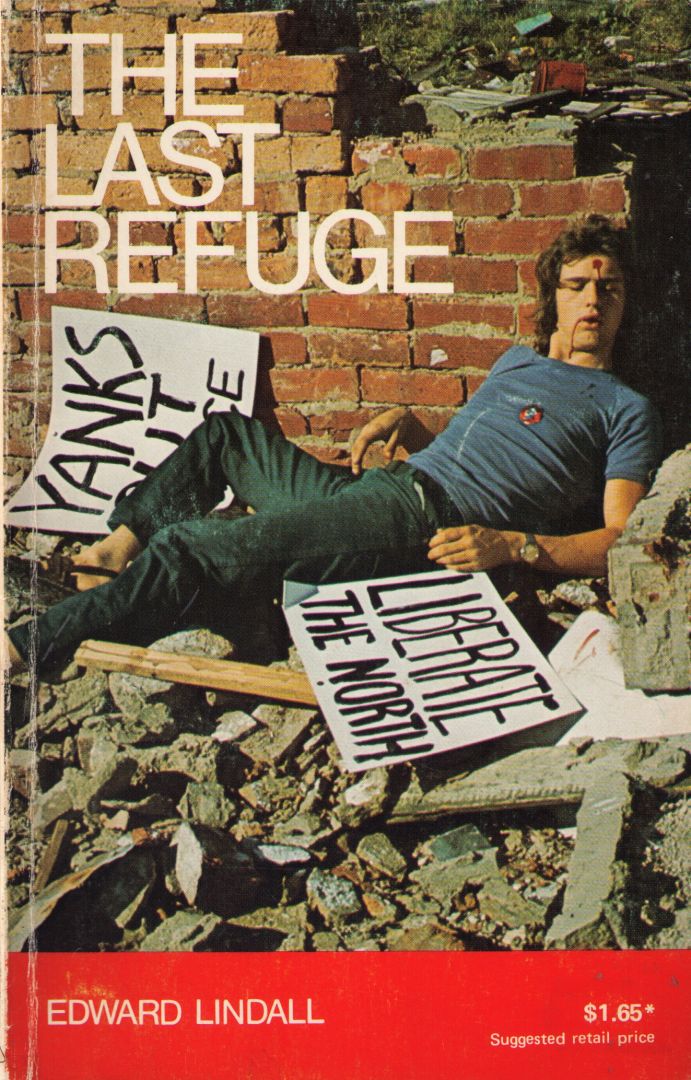 Today’s Pulp Friday is a little known but interesting book, The Last Refuge by Edward Lindall, published in 1972.
Today’s Pulp Friday is a little known but interesting book, The Last Refuge by Edward Lindall, published in 1972.
It’s interesting for two reasons.
First, it was an attempt to set a spy thriller amid the radical student politics taking place in Australia in the early seventies.
The second reason is the publisher, a little known Melbourne-based pulp publishing outfit called Gold Star Publications.
The main character of The Last Refuge is Jay Landon, an Australian Security and Intelligence Organisation agent, assigned the mission of infiltrating and destabalising a group of Maoists, led by Peking agent, Clyde Mansell. The Maoists have left their inner city terraces for the wide expanse of the Australia’s north to wage guerrilla war against US multinationals stripping the country of its mineral wealth.
Lindall’s real name was Ernest Edward Smith, an Adelaide based journalist and writer who penned 13 books, mainly crime and thrillers, but also some science fiction. He died in 1979. The Last Refuge, the only of his books released by Gold Star Publications, taps into the very real politics of what was the most physically and politically aggressive of the radical student groups operating on Australian campuses in the early seventies.
Here’s the back cover blurb:
“There’s always two sides to any story. Jay Landon, Australian Security and Intelligence agent found out.
Caught between the dollar-hungry Americans who wished, with the complicity of the Australian Government, to buy out the Northern Territory, and a bunch of Maoist Australian guerrillas, who were prepared to use all methods to stop the deal, Landon had to play a cool game and win.
To win this deadly game, Landon has to face more than death; to infiltrate a radical political group takes a lot of guts. And that’s what makes a security agent. But it’s not all business and amidst the clash of ideologies and personalities, Landon, as do all secret agents, found a tasty bird in the midst of the fighting.
But this isn’t a romance story, sex like politics can be a hard struggle, and this novel is a hard-hitting, fast moving spy thriller set in a fast moving hard-hitting country.”
Based in Hawthorn, Gold Star Publications appeared to have a left wing, nationalist bent, in keeping with the politics of the time.
It brought out a number of books in the early seventies. These included non-fiction works on topics related to Australiana, sexuality, humour and industrial policy. It also released several works of fiction. Another of Gold Star’s crime offerings was called The Creeping City, a tale of corruption and labour politics set on Melbourne’s wharves.
As was the case with most locally produced pulp in the early seventies, Gold Star’s books mostly feature photographic covers, like the one for The Last Refuge, which help them to convey a wonderful fly on the wall tabloid feel.
I have so far been unable to locate anyone involved in Gold Star Publications. Most of the authors they published appear to be dead and even tracking down a complete list of their books has proven difficult.
There are a lot more Australian pulp covers from the seventies, including for the few Gold Star books I have been able to track down, on my Pinterest site.




















Neat stuff, Andrew, and very eye-opening for those of us who would never have encountered the Australian pulp scene otherwise. There’s just enough of the familiar in this cover to take me back to that era, but much of its content (pictorial and otherwise) has the (delightful) shock of the new.
David,
Cheers and thanks for stopping by. Yes, this book is a really little gem of a cultural artefact from the seventies. They don’t make them like this any more.
Andrew